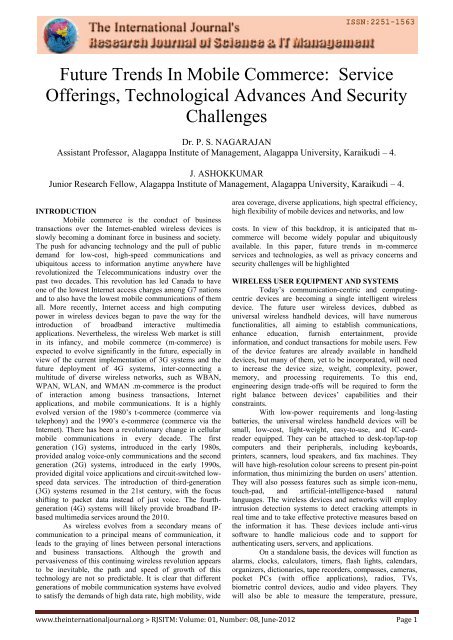Research Journal of Science & IT Management - RJSITM - The ...
Research Journal of Science & IT Management - RJSITM - The ...
Research Journal of Science & IT Management - RJSITM - The ...
Create successful ePaper yourself
Turn your PDF publications into a flip-book with our unique Google optimized e-Paper software.
Future Trends In Mobile Commerce: Service<br />
Offerings, Technological Advances And Security<br />
Challenges<br />
Dr. P. S. NAGARAJAN<br />
Assistant Pr<strong>of</strong>essor, Alagappa Institute <strong>of</strong> <strong>Management</strong>, Alagappa University, Karaikudi – 4.<br />
J. ASHOKKUMAR<br />
Junior <strong>Research</strong> Fellow, Alagappa Institute <strong>of</strong> <strong>Management</strong>, Alagappa University, Karaikudi – 4.<br />
INTRODUCTION<br />
Mobile commerce is the conduct <strong>of</strong> business<br />
transactions over the Internet-enabled wireless devices is<br />
slowly becoming a dominant force in business and society.<br />
<strong>The</strong> push for advancing technology and the pull <strong>of</strong> public<br />
demand for low-cost, high-speed communications and<br />
ubiquitous access to information anytime anywhere have<br />
revolutionized the Telecommunications industry over the<br />
past two decades. This revolution has led Canada to have<br />
one <strong>of</strong> the lowest Internet access charges among G7 nations<br />
and to also have the lowest mobile communications <strong>of</strong> them<br />
all. More recently, Internet access and high computing<br />
power in wireless devices began to pave the way for the<br />
introduction <strong>of</strong> broadband interactive multimedia<br />
applications. Nevertheless, the wireless Web market is still<br />
in its infancy, and mobile commerce (m-commerce) is<br />
expected to evolve significantly in the future, especially in<br />
view <strong>of</strong> the current implementation <strong>of</strong> 3G systems and the<br />
future deployment <strong>of</strong> 4G systems, inter-connecting a<br />
multitude <strong>of</strong> diverse wireless networks, such as WBAN,<br />
WPAN, WLAN, and WMAN .m-commerce is the product<br />
<strong>of</strong> interaction among business transactions, Internet<br />
applications, and mobile communications. It is a highly<br />
evolved version <strong>of</strong> the 1980’s t-commerce (commerce via<br />
telephony) and the 1990’s e-commerce (commerce via the<br />
Internet). <strong>The</strong>re has been a revolutionary change in cellular<br />
mobile communications in every decade. <strong>The</strong> first<br />
generation (1G) systems, introduced in the early 1980s,<br />
provided analog voice-only communications and the second<br />
generation (2G) systems, introduced in the early 1990s,<br />
provided digital voice applications and circuit-switched lowspeed<br />
data services. <strong>The</strong> introduction <strong>of</strong> third-generation<br />
(3G) systems resumed in the 21st century, with the focus<br />
shifting to packet data instead <strong>of</strong> just voice. <strong>The</strong> fourthgeneration<br />
(4G) systems will likely provide broadband IPbased<br />
multimedia services around the 2010.<br />
As wireless evolves from a secondary means <strong>of</strong><br />
communication to a principal means <strong>of</strong> communication, it<br />
leads to the graying <strong>of</strong> lines between personal interactions<br />
and business transactions. Although the growth and<br />
pervasiveness <strong>of</strong> this continuing wireless revolution appears<br />
to be inevitable, the path and speed <strong>of</strong> growth <strong>of</strong> this<br />
technology are not so predictable. It is clear that different<br />
generations <strong>of</strong> mobile communication systems have evolved<br />
to satisfy the demands <strong>of</strong> high data rate, high mobility, wide<br />
area coverage, diverse applications, high spectral efficiency,<br />
high flexibility <strong>of</strong> mobile devices and networks, and low<br />
costs. In view <strong>of</strong> this backdrop, it is anticipated that m-<br />
commerce will become widely popular and ubiquitously<br />
available. In this paper, future trends in m-commerce<br />
services and technologies, as well as privacy concerns and<br />
security challenges will be highlighted<br />
WIRELESS USER EQUIPMENT AND SYSTEMS<br />
Today’s communication-centric and computingcentric<br />
devices are becoming a single intelligent wireless<br />
device. <strong>The</strong> future user wireless devices, dubbed as<br />
universal wireless handheld devices, will have numerous<br />
functionalities, all aiming to establish communications,<br />
enhance education, furnish entertainment, provide<br />
information, and conduct transactions for mobile users. Few<br />
<strong>of</strong> the device features are already available in handheld<br />
devices, but many <strong>of</strong> them, yet to be incorporated, will need<br />
to increase the device size, weight, complexity, power,<br />
memory, and processing requirements. To this end,<br />
engineering design trade-<strong>of</strong>fs will be required to form the<br />
right balance between devices’ capabilities and their<br />
constraints.<br />
With low-power requirements and long-lasting<br />
batteries, the universal wireless handheld devices will be<br />
small, low-cost, light-weight, easy-to-use, and IC-cardreader<br />
equipped. <strong>The</strong>y can be attached to desk-top/lap-top<br />
computers and their peripherals, including keyboards,<br />
printers, scanners, loud speakers, and fax machines. <strong>The</strong>y<br />
will have high-resolution colour screens to present pin-point<br />
information, thus minimizing the burden on users’ attention.<br />
<strong>The</strong>y will also possess features such as simple icon-menu,<br />
touch-pad, and artificial-intelligence-based natural<br />
languages. <strong>The</strong> wireless devices and networks will employ<br />
intrusion detection systems to detect cracking attempts in<br />
real time and to take effective protective measures based on<br />
the information it has. <strong>The</strong>se devices include anti-virus<br />
s<strong>of</strong>tware to handle malicious code and to support for<br />
authenticating users, servers, and applications.<br />
On a standalone basis, the devices will function as<br />
alarms, clocks, calculators, timers, flash lights, calendars,<br />
organizers, dictionaries, tape recorders, compasses, cameras,<br />
pocket PCs (with <strong>of</strong>fice applications), radios, TVs,<br />
biometric control devices, audio and video players. <strong>The</strong>y<br />
will also be able to measure the temperature, pressure,<br />
www.theinternationaljournal.org > RJS<strong>IT</strong>M: Volume: 01, Number: 08, June-2012 Page 1
















